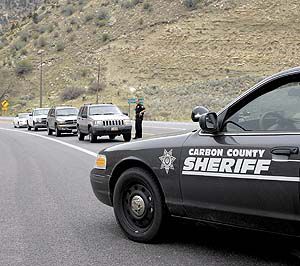| A Carbon County sheriff deputy directs traffic to U.S. Highway 191 after the explosion of a tanker truck carrying unleaded gasoline in the Red Narrows closed the route through Spanish Fork and Price canyons. |
State public safety officials closed U.S. Highway 6 between Spanish Fork and Helper yesterday afternoon after a tanker truck hauling unleaded gasoline reportedly rolled and exploded near milepost 191 in Spanish Fork Canyon.
The unidentified truck driver involved the April 24 explosion is reported to have received third degree burns to 90 percent of his body.
The victim was flown by helicopter to the University of Utah Medical Center burn unit, where officials indicated that he was listed in critical condition.
Although the truck driver was seriously injured in the traffic accident, the victim was apparently alert enough at the accident scene to inform emergency responders as to the contents of the tanker he had been hauling.
No other vehicles were reported to have been involved in the incident.
A spokesperson for the Utah Department of Transportation indicated that state officials will assess the damage to the road once the wreckage is cleared.
Closed for more almost six hours, the department of public safety reopened the highway at 7 p.m. on Monday evening. However, UDOT officials expected to have road construction crews repairing the damage at the accident scene within the next couple of days to weeks.
“It appears that the driver was going too fast for the curve and ended up rolling,” indicated Derek Jensen, spokesperson for the Utah Department of Public Safety.
The tanker had apparently picked up a load of fuel in Evanston, Wyo., and was en route to New Mexico. The tanker was operated by Quick Trans, a private contractor, said Jensen.
The April 24 accident is at least the third incident occurring within the past year involving the spill of a volatile substance hauled by commercial trucks along U.S. Highway 6 in Utah.
Last month, a truck spilled an estimated 40,000 pounds of explosives in Wellington. That incident triggered the evacuation of hundreds of homes and businesses.
The cargo of the vehicle was confirmed to be ammonium nitrate, the same explosive material used to destroy the Alfred P. Murrah Federal Building in Oklahoma City, Okla., on April 19, 1995.
At a Carbon commission meeting last week, Jason Llewelyn, a member of the county HAZMAT crew, said that three trucks carrying similar cargo and operated by the same company travel through the local area on a daily basis.
Llewelyn explained that the material in Wellington was the premixed explosive and was in a volatile form while transported.
The HAZMAT crew member compared the local situation to the incident in Oklahoma, explaining that the truck in Wellington contained 800 bags of the explosive, weighing 50 pounds each.
The truck that caused the damage in Oklahoma was carrying an estimated 2,100 pounds of explosives. By comparison, the truck that spilled a load in Wellington contained nearly 50 times the amount used in Oklahoma.
In a four-year-old study, it was estimated that at least 40 million pounds of hazardous material are transported through Carbon County in any given week, continued Llewelyn.
The figures were for highway traffic only and did not include rail, plane or any other traffic through the area.
In August 2005, a truck in nearly the same location as the incident yesterday exploded when it tipped in the Red Narrows, leaving a 30-foot deep crater.
Last year’s incident closed U.S. Highway 6 for more than 36 hours while crews rebuilt road that was destroyed by the explosion.
The April 24 incident comes just days after Carbon commissioners approved a hike in rates for services performed by the county hazardous material response team last week.
While the county’s HAZMAT team was not reported to have been dispatched to the scene, similar incidents have been increasing in the county.
Llewelyn explained to the commissioners that the costs assessed by the county for its HAZMAT response were significantly lower than the expenses calculated by officials in other areas of the state.
Llewelyn told the commissioners that he had met with fire departments and hazardous material teams along the Wasatch Front and discovered that counterparts in the regions charge significantly more than Carbon County.
“I couldn’t figure out why everyone was so happy to pay our bill,” commented the HAZMAT team member. “We were so grossly undercharging that it wasn’t funny.”
Another change proposed by Llewelyn was to combine ambulance and HAZMAT billing into a single document when the county provides both services.
He explained that insurance agencies expect the county to send them a single bill for services provided, whereas ambulance and HAZMAT currently send separate bills.
Llewelyn pointed out that other departments such as the county road department should add charges to the same bill.
The recommended process would generate a single bill stating all charges assessed by the county, said the HAZMAT crew member.
County commissioners approved a redrafting of the HAZMAT billing process to update costs to be more in line with other government entities and providing the ability to bill multiple department charges on a single bill.

